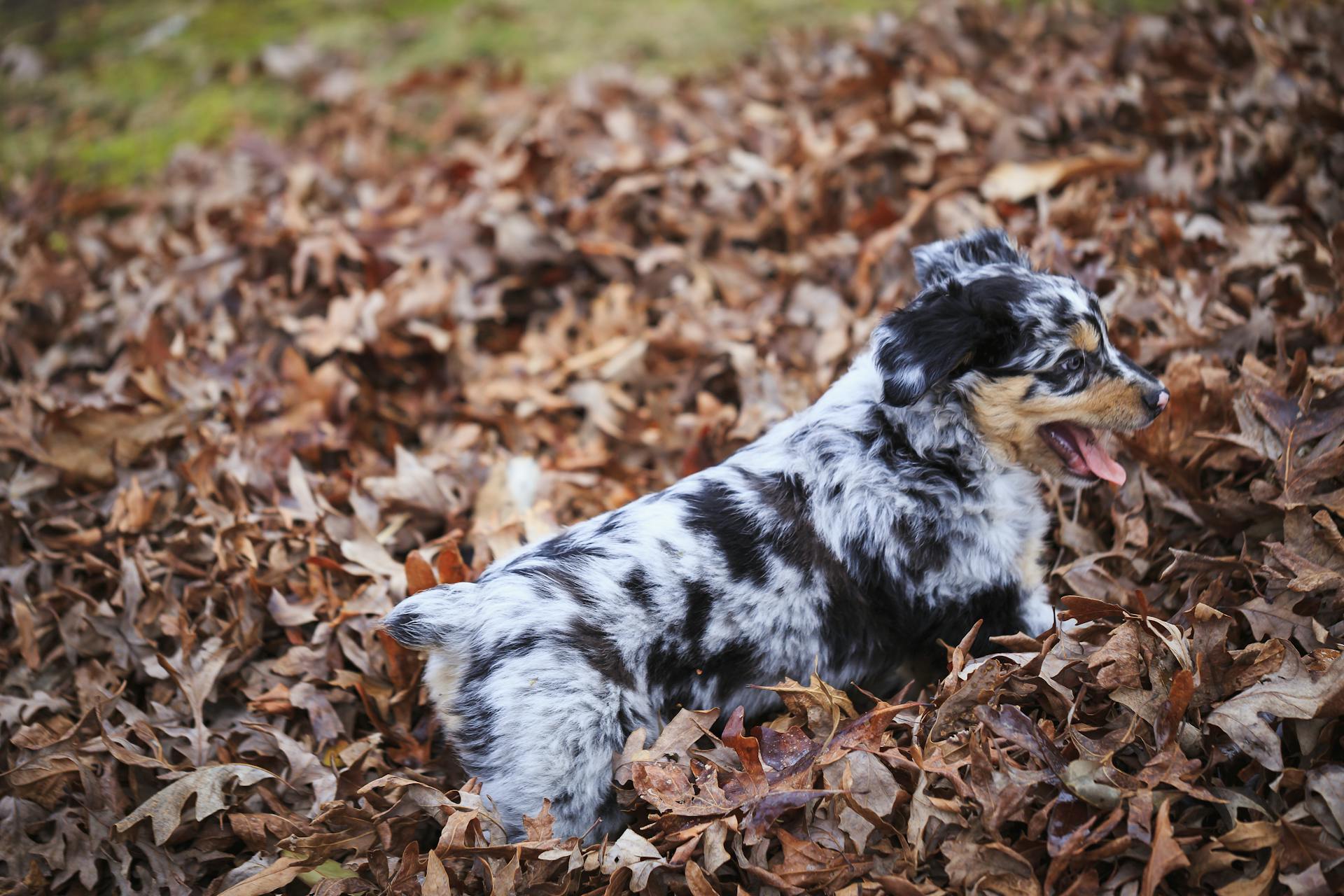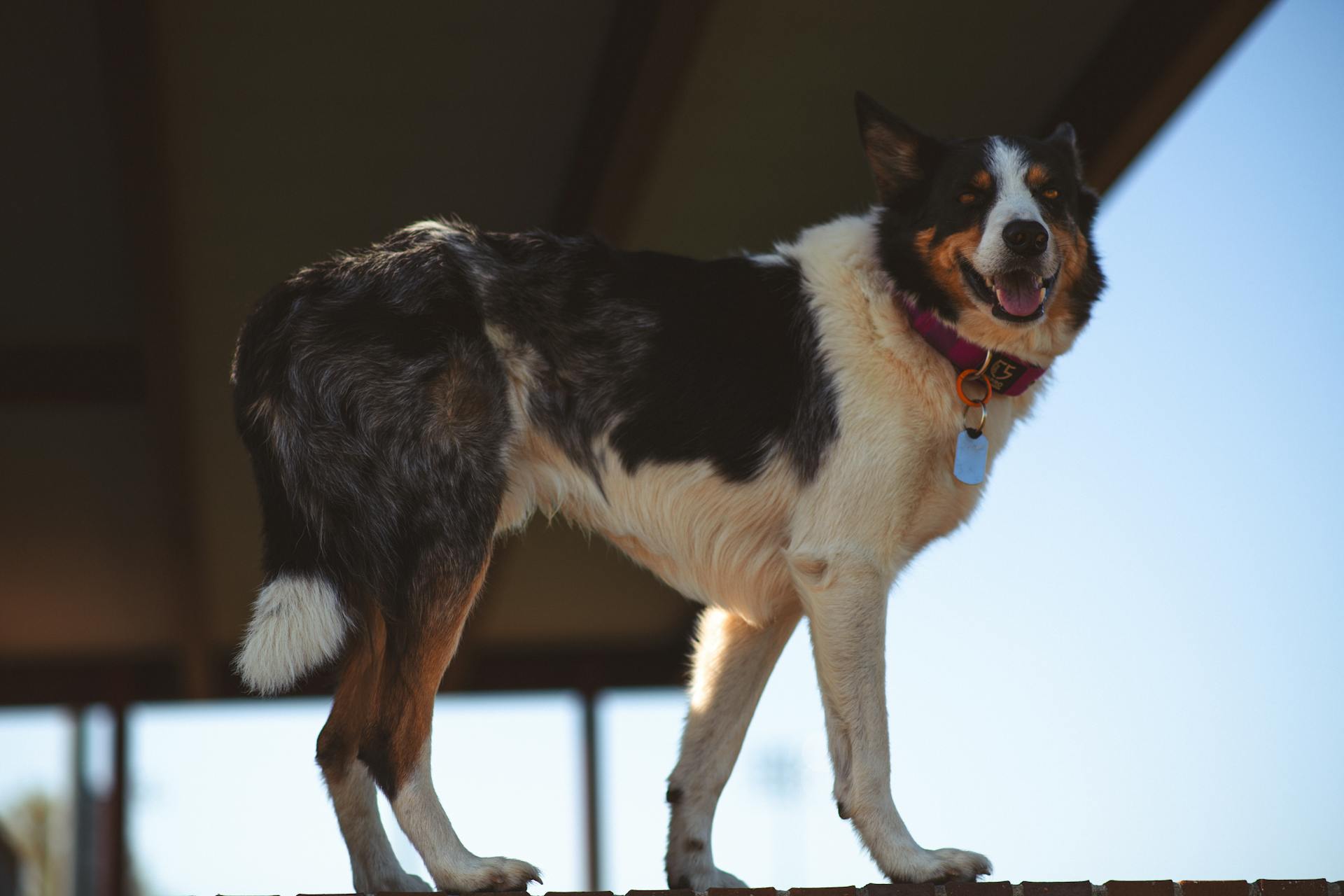
As a responsible Mini Aussie owner, it's essential to be aware of the potential health issues that can affect your furry friend. Mini Aussies are generally a healthy breed, but like all dogs, they can be prone to certain health problems.
Hip dysplasia is a common issue in Mini Aussies, which can lead to arthritis and mobility problems if left untreated. This is often inherited from their parent breeds, making it crucial to work with a reputable breeder who prioritizes genetic health testing.
Mini Aussies are also at risk of eye problems, including Progressive Retinal Atrophy (PRA) and cataracts, which can cause blindness if not addressed promptly. Regular eye exams with a veterinarian can help detect these issues early on.
Mini Aussies are a relatively small breed, but they still require regular exercise and mental stimulation to prevent boredom and obesity.
A different take: Dog Health Issues by Breed
Australian Shepherd Health Issues
Miniature Australian Shepherds are generally healthy dogs, but they can be prone to certain health issues.
Their average life expectancy is 12 to 13 years, which is typical for dogs of their size.
These dogs can be sensitive to some medications due to a multidrug resistance mutation.
Some common eye problems include progressive retinal atrophy, iris colobomas, collie eye anomaly, and microphthalmia.
Hip dysplasia and elbow dysplasia are also potential health issues.
Degenerative myelopathy is another condition that can affect miniature Australian Shepherds.
Here are some of the common health issues that can arise with miniature Australian Shepherds:
- Multidrug resistance mutation
- Progressive retinal atrophy
- Iris colobomas
- Collie eye anomaly
- Microphthalmia
- Hip dysplasia
- Elbow dysplasia
- Degenerative myelopathy
Orthopedic Disorders
Australian Shepherds are prone to certain health issues that affect their orthopedic system. Hip dysplasia is a common problem in this breed, where the head of the femur doesn't fit properly into the acetabulum, leading to joint deterioration and pain.
Hip dysplasia can be congenital or caused by injury. A Licensed Veterinarian should radiograph (x-ray) hips on all breeding stock and submit the results to the Orthopedic Foundation for Animals (OFA), PennHIP, or a nationally accepted registry.
Hip dysplasia is inherited polygenically, which means it's passed down from parents to offspring. The best prevention is to breed only those dogs that have been certified free of hip dysplasia. This can be achieved by selecting parents with good hip health and having their hips evaluated.
Diet can affect the expression of hip dysplasia in genetically predisposed dogs, but it won't prevent the condition in non-affected stock. Feeding regimens may be a factor, but it's not a foolproof solution.
Another orthopedic issue affecting Australian Shepherds is patellar luxation, where the kneecap pops out of place. This condition is often inherited and can be present at birth, even if the luxation isn't noticeable.
Here's a summary of the common orthopedic disorders affecting Australian Shepherds:
- Canine Hip Dysplasia (CHD)
- Luxating Patella
CCL Injuries
Australian Shepherds are prone to CCL injuries due to their high activity level and risk for joint problems. This is the most common joint injury in dogs.
CCL injuries often occur during activities like running, agility, and jumping. These activities can put a lot of stress on the knee joint.
Rest is sometimes used to help the CCL heal, which can take weeks or months. However, surgery is usually required if the CCL has been mostly or fully torn.
There are a few surgical techniques that can be used to repair the CCL, but your primary vet may not feel comfortable performing the surgery. In many cases, an orthopedic surgeon must repair the ligament.
Worth a look: English Bulldog Soft Palate Surgery
Australian Shepherd Size and Diet
Australian Shepherds come in two sizes: miniature and full-size. Miniature Australian Shepherds typically weigh between 20 and 40 pounds and stand between 13 and 18 inches tall.
Their growth rate is significant, with males and females weighing between 9 and 18 pounds at just 3 months old. By 12 months, they can weigh anywhere from 20 to 40 pounds.
Here's a breakdown of their growth chart:
To keep your miniature Australian Shepherd healthy, it's essential to feed them a high-quality, nutritionally complete dog food. Puppies need more calories per day than adults, and their diet should be divided into at least two meals for adults and three to four meals for puppies.
Australian Shepherd Size
Miniature Australian Shepherds typically weigh between 20 and 40 pounds when fully grown, with females weighing less than males.
Females of this breed stand between 13 and 17 inches in height, while males are more like 14 to 18 inches tall at the shoulder.
Their growth rate is quite significant, with males and females weighing between 9 to 18 pounds at just 3 months old.
By 6 months, they can weigh anywhere from 14 to 28 pounds, and by 9 months, they'll likely be around 17 to 34 pounds.
Some miniature Australian Shepherds reach their final adult weight by about nine months of age, while others will keep growing slightly until they are a year or a year and a half old.
Here's a rough idea of what to expect at different ages:
Diet and Nutrition
Australian Shepherds are active dogs, so they need a diet that fuels their energy. Most adult dogs thrive on high-quality, nutritionally complete and balanced dog food.
Puppies should eat puppy food until they are 10-12 months old. A veterinary nutritionist should design the recipe to ensure it's suitable for your dog's age and health status.
Feed your Australian Shepherd the right amount of food to keep them slim. You should be able to see their waist and feel (but not see) their ribs without having to press too hard.
Puppies need more calories per day than adults, but a dog's needs vary with their activity level and other factors. Don't leave food out all day for your Australian Shepherd to graze on.
Divide the daily food amount into at least two meals for adults and three to four meals for puppies. Place the food out in a bowl at approximately the same time each day, such as in the morning and evening.
Australian Shepherd Insurance and Care
Australian Shepherds are a popular breed, but they do require proper insurance and care to ensure their well-being.
Regular veterinary check-ups are crucial for mini Aussies, with the average lifespan being 12-15 years.
They are prone to certain health issues, including hip dysplasia, which affects about 15% of the breed.
Their intelligence and high energy levels make them a great fit for active families, but also mean they need plenty of exercise and mental stimulation.
Mini Aussies are generally a healthy breed, but they can be susceptible to eye problems, such as cataracts and progressive retinal atrophy.
A well-balanced diet and regular exercise can help prevent or manage many of these health issues.
Australian Shepherds are also prone to allergies, which can cause skin issues and ear infections.
Their thick coats require regular grooming to prevent matting and tangling.
Mini Aussies are highly intelligent and trainable, making them a great breed for first-time dog owners.
Their high energy levels mean they need plenty of physical and mental stimulation to prevent boredom and destructive behavior.
A good insurance policy can help cover the costs of unexpected veterinary bills, which can be a significant financial burden.
Expand your knowledge: Do Pit Bulls Need a Lot of Exercise
Specific Health Problems
Miniature Australian Shepherds are generally a healthy breed, but they can be prone to certain health issues.
Their average life expectancy is 12 to 13 years, which is typical for dogs of their size.
Miniature Australian Shepherds are susceptible to a variety of health problems, including multidrug resistance mutation, which can make them sensitive to certain medications.
Some common eye problems that can affect Miniature Australian Shepherds include progressive retinal atrophy and other issues like iris colobomas, collie eye anomaly, and microphthalmia.
They can also be prone to hip dysplasia and elbow dysplasia.
Here are some common health issues that can affect Miniature Australian Shepherds:
- Progressive retinal atrophy
- Hip dysplasia
- Elbow dysplasia
- Blindness and deafness in merle and merle crosses
Eye Disorders
Eye Disorders can be a significant concern for miniature Australian shepherd owners. Some common eye problems include iris colobomas, collie eye anomaly, and microphthalmia.
These conditions can lead to blindness or vision loss in severe cases. In some instances, dogs may be born blind due to these conditions.
Collie eye anomaly, or CEA, is a hereditary disease that can cause physical abnormalities in the eyes. It's often found in breeds like Collies, Shelties, Aussies, Border Collies, and Nova Scotia Duck Tolling Retrievers.
While CEA can't be treated in most cases, it usually doesn't affect a dog's quality of life. However, it's essential to monitor the eye for changes and damage.
Distichiasis is another eye condition that can cause painful ulcers and corneal scarring. It occurs when eyelashes grow from the wrong portion of the eyelid, rubbing against the eyes.
Non-surgical treatments, such as lubricating and protecting the eye with medications, can help manage distichiasis. In more severe cases, surgical treatment may be necessary, using methods like electrocautery, cryosurgery, or laser.
Here are some common eye problems found in miniature Australian shepherds:
- Multidrug resistance mutation
- Progressive retinal atrophy
- Iris colobomas
- Collie eye anomaly
- Microphthalmia
- Distichiasis
Allergies
Allergies can be a real challenge for some Australian Shepherds and mini Aussies. Chronic flea allergies and excessively dry skin have been observed in certain lines.
For your interest: Cavapoo Food Allergies
Inheritance of these allergies is simple co-dominant, which means breeders need to be cautious to avoid perpetuating the problem.
For dogs suffering from flea allergies, using a combination of Program with a topical flea preventive can be a good solution.
Ivermectin sensitivity is another issue that some Australian Shepherds and mini Aussies may face. This sensitivity can cause serious symptoms, including depression, excitability, seizures, and even coma or death.
See what others are reading: Seresto Small Dog Flea Collar
Hypothyroidism
Hypothyroidism is a disease that causes the decreased function of the thyroid gland, affecting dogs, cats, and humans alike.
It's a relatively common condition in dogs, and Aussies are particularly susceptible to developing it due to a genetic component.
Hypothyroidism can cause lethargy, weight gain, and difficulty losing weight, as well as changes to the skin and coat.
Auto-immune disorders like thyroiditis are a common cause of hypothyroidism, and it's one of the most common auto-immune disorders in Aussies.
Treating hypothyroidism involves lifelong medications and routine lab tests to ensure the dog's thyroid levels are in check.
Maintaining a healthy body weight through diet and exercise is crucial for dogs with hypothyroidism, as obesity is a common complication.
In fact, it's extremely difficult to help dogs with hypothyroidism lose weight, making healthy weight management a top priority.
For more insights, see: Preventative Care Keeping Your Pet Healthy Year-Round
Elbow Dysplasia
Elbow dysplasia is the same thing as hip dysplasia, but it occurs within the elbow joint instead. It's far less common than hip dysplasia, but it still occurs with some frequency within the Australian Shepherd breed.
This condition can appear very early in life or later in life, and it will worsen over time if left untreated. Elbow dysplasia is characterized by looseness within the elbow joint, leading to the cartilage and bone to wear down over time.
Elbow dysplasia can be managed through supplements, medications, and an appropriate exercise regimen. Few surgical options are available for dogs that do not respond to medical management.
The best way to prevent elbow dysplasia is to continue breeding only those dogs that have been certified free of the condition. However, this is not a guarantee, and some dogs may still be prone to elbow dysplasia even if their parents are healthy.
Here's a comparison of hip and elbow dysplasia:
It's essential to work with a veterinarian to develop a treatment plan for your dog if they're diagnosed with elbow dysplasia. With proper care and management, you can help your dog live a more comfortable life despite this condition.
Frequently Asked Questions
What is the life expectancy of a mini Aussie?
Mini Australian Shepherds typically live for 12 to 15 years with proper care. A long and healthy life is within reach with the right nutrition, exercise, and veterinary care.
Sources
- https://blog.healthypawspetinsurance.com/breed-guide-miniature-australian-shepherd
- https://www.masca-online.com/breed-info/health/
- https://www.dogster.com/dog-health-care/australian-shepherd-health-issues
- http://www.bestlittleaussies.com/heath-conditions-and-genetic-testing/
- https://www.gooddog.com/breeds/miniature-australian-shepherd/health-testing-guide
Featured Images: pexels.com


